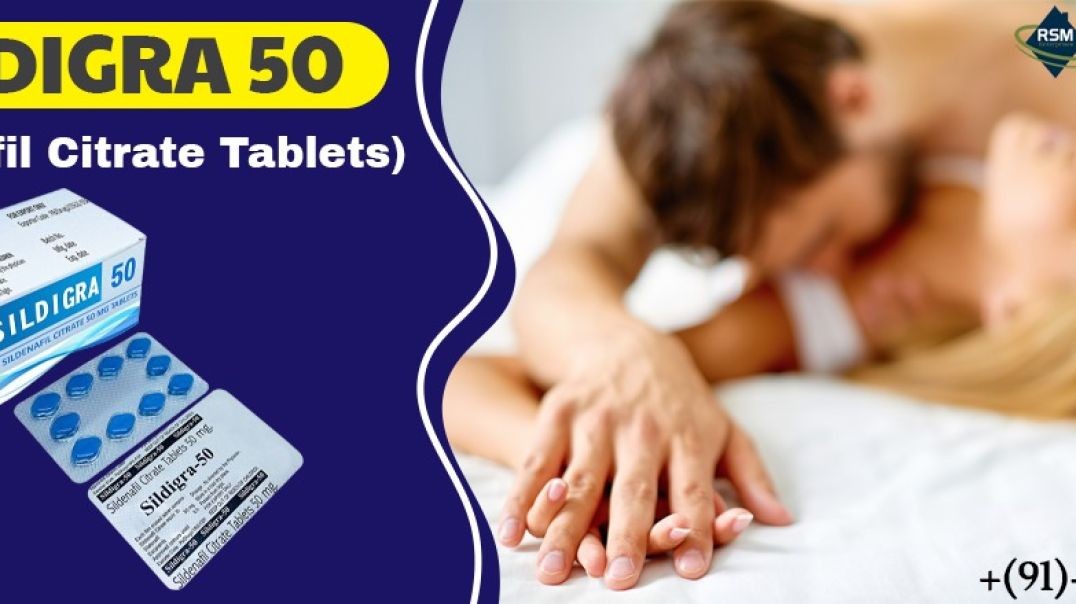Top videos
Bacterial infections are common health issues caused by pathogenic bacteria.
RSM Enterprises offers a wide range of Vardenafil 20mg (Snovitra 20mg) which help stimulate the blood flow to the penis. Vardenafil 20mg Tablets are useful for treatment of ED (erectile dysfunction) in men.
Chat on WhatsApp with +91 92163-25377
Buy Now : https://www.rsmenterprises.in/....product/viewdetail/v
#rsmenterprises #health #healthcare #snovitra20mg #vardenafil20mg #maleedmedicine #edmedicine
If you have a lung disease, a type of surgery called a lobectomy is one treatment option your doctor may suggest. Your lungs are made up of five sections called lobes. You have three in your right lung and two in your left. A lobectomy removes one of these lobes. After the surgery, your healthy tissue makes up for the missing section, so your lungs should work as well or better than they did before.
Buy Online Sildigra 50mg Cheap Price from rsmenterprises can be used to manage erectile disorder (ED or Impotence). It comprises Sildenafil 50mg.
Chat on WhatsApp with +91 92163-25377
Buy Now : https://www.rsmenterprises.in/....product/viewdetail/s
#rsmenterprises #health #healthcare #sildigra50mg #sildenafil50mg #genericviagra #maleviagra #maleedmedicine
If your huge breasts are causing you massive discomfort and social embarrassment, but you’ve heard some bad things about breast reduction surgery, this is the perfect video for you!
Dr Rajat Gupta, our board-certified plastic surgeon, working in New Delhi, having done this surgery over 500 times, is here to share his expertise on the procedure! He has also identified five significant myths and fallacies surrounding this procedure, and he meticulously dispels each while providing solid reasoning at every step. So, if you're looking for a permanent way to reduce your breast size and get aesthetic, painless results, sit back and watch as Dr Gupta explains precisely what this procedure entails!
–––––––––––––––––––––––––––––––
About Dr. Rajat Gupta and RG Aesthetics
At RG Aesthetics, India’s best plastic surgeon, Dr. Rajat Gupta is at your service! With 10 years of experience, brand-certification, and international recognition, Dr. Gupta is the solution to all your contouring needs.
His expertise in liposuction techniques combined with the state-of-the-art technology available at RG Aesthetics ensures we continue providing the most reliable services with incredible, instantaneous results!
Our equipment allows for every kind of liposuction there is – especially the non-invasive kinds. Dr. Gupta reflects RG Aesthetics’ belief of the patient’s comfort always being paramount. Procedures at RG Aesthetics, under Dr. Rajat Gupta, minimize trauma and speed up recovery time for the best results!
#breastreductionsurgery #cosmeticsurgery #drrajatgupta #rgaesthetics #breastlift
An animated description of the composition of bones.
Visit www.orthofilms.com for more videos and info.
The video will show features of tuberculosis on chest x-ray. Please see disclaimer on my website www.academyofprofessionals.com
More than three decades on from its first outbreak, HIV/AIDS remains a prevalent killer, even in the developed world, and a pressing scientific challenge to understand and treat. The rate of infection, especially among young people, is increasing, and in parts of Africa in particular, it remains an epidemic-scale killer. Yet a cure could be just around the corner, and scientists are optimistic that the virus’ days might be numbered. Is HIV here to stay, or will it be consigned to history like Smallpox? Produced by ABC Australia - Ref-6621 Journeyman Pictures brings you highlights from the cutting-edge science series, ‘Catalyst’, produced by our long-term content partners at ABC Australia. Every day we’ll upload a new episode that takes you to the heart of the most intriguing and relevant science-related stories of the day, transforming your perspective of the issues shaping our world.
Tadapox 80mg Tablets are a combination medication used primarily for the treatment of erectile dysfunction and premature ejaculation. It combines Tadalafil and Dapoxetine etc.
Buy Now : https://tinyurl.com/buy-tadapox-80mg-tablets
#rsmenterprises #health #healthcare #tadapox80mg #tadalafil20mg #dapoxetine80mg #genericcialis #malecialis
Simply put, there isn’t enough room for wisdom teeth because our jaws don’t grow to be big enough to have enough space for them to come in. Since there isn’t enough room for them to erupt properly, wisdom teeth tend to come in at an angle or they don’t fully emerge, which causes problems for the rest of the mouth. Third molars (the wisdom teeth) routinely damage the teeth right next door, called second molars. Dentists recommend removing wisdom teeth before they become a problem and to avoid a more complicated surgery. Read more at Ask the Dentist: https://askthedentist.com/wisdom-teeth-removal/
Male To Female Gender Reassignment Surgery
Watch that video of Human Skull Opening and Brain Removal During Autopsy
Breast Augmentation Surgery in Delhi: Empowering Confidence
Breast augmentation surgery is a procedure that involves the use of implants to enhance the size and shape of the breasts. It is one of the most popular cosmetic surgeries performed globally, and Delhi offers some of the best options in India for individuals seeking to achieve a fuller and more symmetrical breast appearance.
Why Choose Breast Augmentation Surgery?
Enhanced Aesthetic Appeal
Many women choose breast augmentation surgery to create a more balanced and proportionate figure. For those with naturally small breasts or those who have lost breast volume due to factors like pregnancy, weight fluctuations, or aging, breast implants can help restore the volume and shape of their breasts.
Ultrasound of Heart
The video will shed light on left upper lobe collapse
Covers the histological structure for adipose tissue and relevant cellular physiology for adipocytes. This video is a part of our Histology Video Course (https://youtube.com/playlist?l....ist=PLnr1l7WuQdDynxT
All Histology Videos: https://youtube.com/playlist?l....ist=PLnr1l7WuQdDynxT
Thank you to our sponsor Doc2Doc Lending, the Personal Lending platform designed for Doctors, by Doctors. Check out https://doc2doclending.com/davinci to learn more today.
DaVinci Academy Merch - Coffee mugs, T-shirts, hoodies and more: https://my-store-d90f46.creator-spring.com
Additional YouTube Content
Biochemistry videos: https://youtube.com/playlist?l....ist=PLnr1l7WuQdDzCUC
Anatomy Videos: https://youtube.com/playlist?l....ist=PLnr1l7WuQdDz2dK
DaVinci Cases Videos: https://youtube.com/playlist?l....ist=PLnr1l7WuQdDyJUl
The DaVinci Hour Podcast: https://youtube.com/playlist?l....ist=PLnr1l7WuQdDwSm9
DaVinci Academy Website: https://www.dviacademy.com/
Sildalist Strong 140mg is one of the well-known medicines used to treat male erectile dysfunction. It contains two active substances: sildenafil and tadalafil. Both of them act together to enhance the supply of blood to the male genital area, which can result in a strong and longer erection. You can buy Sildalist Strong 140 mg online. Following are some advantages: Among its most important advantages, it is extremely effective, particularly for those patients who have not experienced a satisfactory result with lesser dosages or with other medications taken for ED. Another significant reason, the unique combination of sildenafil and tadalafil used in Sildalist Strong 140 mg can prolong the effect duration and also provides the patient with the ability to more accurately fine-tune his response to such product treatment. Another significant benefit of this product is that it is convenient. It comes in the form of a tablet, and thus it can be consumed discreetly without opting for injections or any invasive methods. This feature is beneficial to the men who are sensitive towards other options available for treatment and are shy about their ED issue. Sildalist Strong 140 mg is, in general, of much importance to the men afflicted with ED.Buy Sildalist Strong 140mg online at our web store https://www.firstchoicemedss.c....om/sildalist-strong-
Midline Episiotomy
Sildenafil Oral Jelly is an effective, fast-acting treatment for erectile dysfunction. This easy-to-take, flavored jelly form of sildenafil citrate offers quick absorption and results, providing relief from ED symptoms in as little as 15 minutes.
Buy Now : https://tinyurl.com/buy-now-Sildenafil-Oral-Jelly
#rsmenterprises #health #healthcare #sildenafiloraljelly #kaminioraljelly #genericviagraoraljelly #edmedicine #maleviagraoraljelly
Watch that Disgusting Skin Jiggers Removing




















